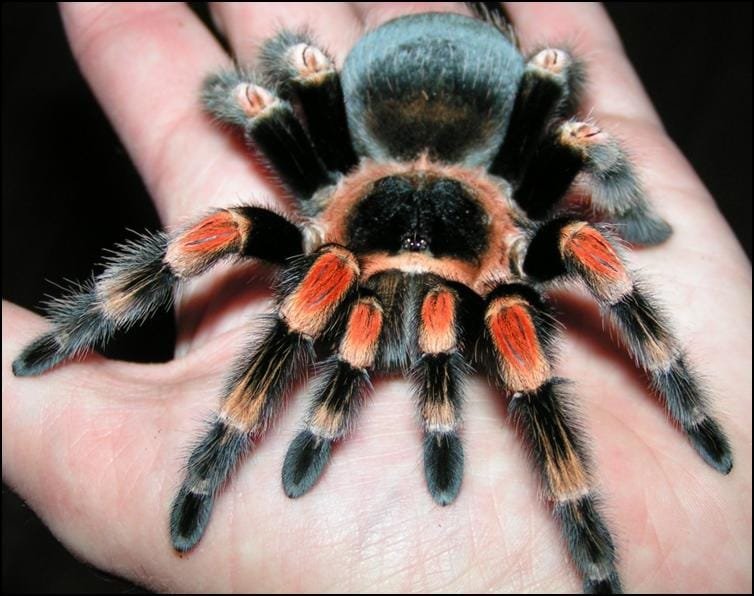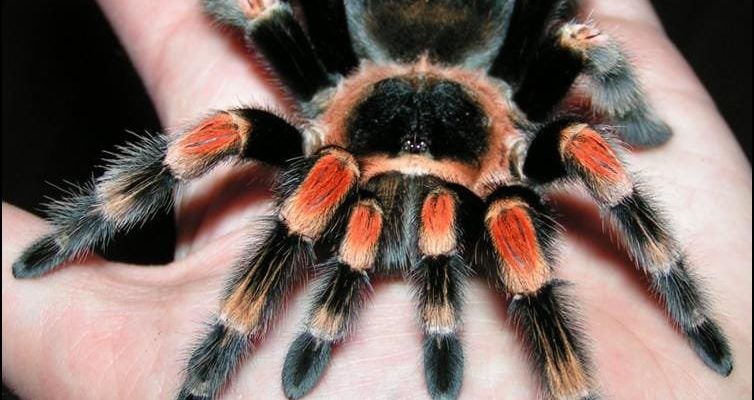
Identifying the Mexican Redknee Tarantula isn’t just about knowing what it looks like; it’s about understanding what makes them unique. Much like recognizing a favorite band just by their sound, you’ll find that some key features can help you spot this specific tarantula. Grab a cup of coffee and let’s dive into the world of Mexican Redknee Tarantulas!
Physical Characteristics of the Mexican Redknee Tarantula
To begin with, let’s talk about what makes the Mexican Redknee Tarantula stand out in a crowd. These spiders are known for their vibrant colors. Typically, you’ll find them sporting a rich, dark brown to black body with bright orange-red knee joints. This eye-catching coloration is a significant giveaway.
Another key feature is their size. Adult Mexican Redknees usually range from 4 to 6 inches in leg span, making them quite large compared to other spiders. Their hefty size might give you pause, but don’t let that scare you! Tarantulas, including the Mexican Redknee, are mostly harmless. Their bite is similar in pain to a bee sting.
If you closely examine the legs of these arachnids, you’ll also notice a slightly fuzzy texture. This fuzziness, or setae, assists in sensing their environment, which is important for a creature that spends a lot of time navigating dark burrows and hiding spots.
Behavioral Traits to Look For
Now that we’ve covered physical features, how about their behavior? A Mexican Redknee Tarantula is typically quite docile and known for being more tolerant of handling than other tarantula species. But here’s the thing: they can still be skittish. If you’re observing one, you might notice it tends to freeze or retreat if it feels threatened. This is a natural instinct for them.
You might also see them making a little webbing around their hideout. Tarantulas like these don’t construct grand webs like garden spiders. Instead, they create a few silk threads to help them feel secure in their environment. It’s kind of like them putting up a tiny security system at their front door!
Additionally, they’re nocturnal hunters. If you’re observing them during the day, don’t expect much action. Most of their hunting and activity occurs at night, which is when they’re out looking for food.
Habitat and Range
Understanding where the Mexican Redknee Tarantula lives can help with identification as well. These spiders are native to the arid regions of Mexico and parts of the southwestern United States, particularly in dry grasslands and scrubby fields. They prefer to stay underground, burrowing into the soil to create cozy homes.
If you ever find yourself in their natural habitat, such as the coastal plains of Mexico, keep an eye out for burrows. These burrows often have a small webbing at the entrance, indicating a resident tarantula.
However, it’s good to note that these tarantulas can also be found in captivity. Many people keep them as pets. If you’re at a pet store and see a tarantula that matches the description we’ve talked about, it’s likely a Mexican Redknee!
Distinguishing Features Compared to Other Tarantulas
You might wonder how to tell a Mexican Redknee Tarantula apart from others, like the Brazilian Black or the Chilean Rose. One of the easiest ways to tell them apart is by those bright orange-red knees. Many other tarantulas lack this distinctive coloring, making the Mexican Redknee unique.
Also, compare their behavior. For instance, Brazilian Black Tarantulas tend to be more defensive and skittish. In contrast, the Mexican Redknee is often seen as more laid-back, making it a popular choice for beginners in the world of tarantula care.
Another point to consider is size. While there’s overlap, Mexican Redknee Tarantulas typically fall within that 4 to 6-inch range, whereas others can be notably larger or smaller.
Care for a Mexican Redknee Tarantula as a Pet
If you’re considering bringing a Mexican Redknee Tarantula into your home, there are some care basics to keep in mind. They thrive in a warm environment that mimics their natural habitat. A temperature range of 70-80°F is ideal. This is like keeping your room cozy, but not too hot, just a comfortable warm spot!
You’ll need a proper enclosure—a glass terrarium is a good choice. It should have enough space for burrowing and hiding, as well as a top to prevent escapes, of course! Providing them with substrate like coconut fiber or peat will mimic their natural burrows, and don’t forget a shallow water dish for hydration.
Feeding them is pretty straightforward. They enjoy a diet of crickets, roaches, and mealworms. Offering food once a week is usually enough, and make sure to remove any uneaten prey to keep the enclosure tidy!
Common Misconceptions
A lot of folks find tarantulas scary, and the Mexican Redknee is no exception. One common myth is that all tarantulas are aggressive. In reality, many species, including the Mexican Redknee, are quite gentle. They’re more likely to run away than attack.
Another misconception is that tarantulas are venomous and dangerous. While they do have venom, it generally poses little risk to humans. For most people, a bite feels no worse than a bee sting. But let’s be clear—you should still handle them with care!
People also often think that tarantulas, including the Mexican Redknee, do not make good pets. But with their calm demeanor and striking beauty, they can be perfect companions for those willing to learn about their needs.
Identifying the Mexican Redknee Tarantula is like discovering a hidden treasure in the world of spiders. With their bright colors, unique behaviors, and fascinating habitats, they’ve carved a niche in both the wild and the hearts of arachnid lovers. Whether you’re interested in them for their beauty, their role in the ecosystem, or as a potential pet, understanding how to pinpoint their characteristics makes you appreciate them even more.
So, the next time you encounter a Mexican Redknee Tarantula—whether in the wild or a pet store—you’ll know exactly what to look for. Just remember to admire them from a respectful distance, and maybe even consider adding one to your life if you’re up for the adventure!

